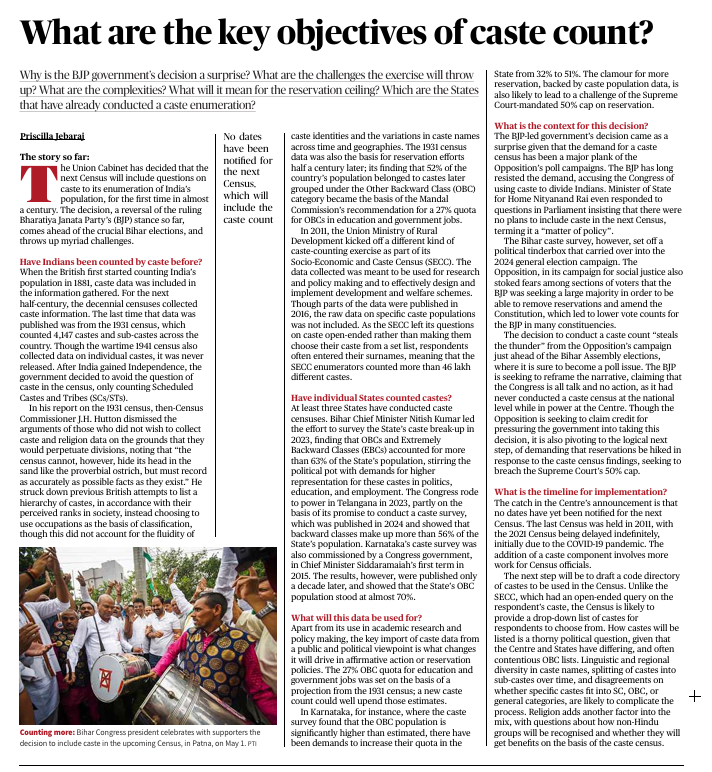Background: Why is this decision significant now?
- Union Cabinet’s move: Caste to be enumerated in the upcoming Census — for the first time in over a century.
- Political shift: Marks a reversal of BJP’s earlier stand opposing caste-based census.
- Timing: Comes ahead of 2024 Lok Sabha elections, amidst growing demands for caste-based social justice.
2. Historical Context: Has caste been counted before?
- First counted in 1881: Caste was included in decennial census data.
- 1931 Census: Last published data on individual caste names and distribution.
- Post-independence: India dropped caste enumeration (except for SC/ST) from the Census.
- 2011 SECC (Socio-Economic and Caste Census):
- Collected data on caste, but never released due to concerns over data quality and complexity.
- Collected data on caste, but never released due to concerns over data quality and complexity.
3. Why is the decision a surprise?
- BJP’s prior stand: Rejected caste census citing it as a “policy matter” and avoided response in Parliament.
- Reversal due to pressure:
- Opposition parties’ campaigns (e.g., Congress, RJD, JD(U)) for social justice and caste-based policies.
- Successful state-level caste surveys (e.g., Bihar) showed strong OBC/EBC populations.
- Growing demand to breach the 50% reservation cap, based on actual caste share.
- Opposition parties’ campaigns (e.g., Congress, RJD, JD(U)) for social justice and caste-based policies.
4. States that have already conducted caste enumeration:
- Bihar (2022): Found 63% of the population were EBC/OBC.
- Chhattisgarh: Survey showed ~70% OBC + EBC.
- Tamil Nadu, Odisha: Also conducted or initiated caste surveys.
- These data have triggered calls for increased reservation quotas and policy representation.
5. What is the purpose of caste count?
- Better policy-making: Updated data needed for welfare targeting and resource allocation.
- Correct social inequities: Data helps understand which castes need more support in education, jobs, health.
- Demands for fair share: Political mobilization to increase OBC quota based on actual population share.
6. Implementation Challenges:
- No notification yet: Centre hasn’t officially notified caste enumeration for the next Census.
- Complexity:
- Caste is fluid and diverse — issues with standardizing names, sub-castes.
- Concerns over accuracy, duplication, and misreporting.
- Caste is fluid and diverse — issues with standardizing names, sub-castes.
- Political implications:
- May impact reservation ceilings, stir demands for quota beyond 50% cap (challenging SC verdict).
- Risk of polarization or identity-based politics.
- May impact reservation ceilings, stir demands for quota beyond 50% cap (challenging SC verdict).
7. What will it be used for?
- Social justice planning: Data to guide policies on education, jobs, housing, and welfare.
- Reservation restructuring: Could lead to revision in reservation shares — especially for OBCs.
- Electoral impact: May influence candidate selection and voter mobilization in upcoming elections.
8. Opposition View:
- Congress and allies:
- Welcome the caste census.
- Termed it necessary for real representation and equity.
- Criticize BJP for earlier resistance and now taking a reactive stance under electoral pressure.
- Welcome the caste census.
9. Key Concerns Raised by Experts:
- Enumerating caste scientifically is difficult.
- May face challenges similar to SECC-2011 (where data was too vast and complex to process).
- Risks strengthening caste divisions instead of removing them.
Conclusion:
The caste census marks a turning point in Indian politics, with deep implications for:
- Social equity
- Welfare targeting
- Reservation reforms
GS Paper I – Society
Q1. Discuss the significance of a caste-based census in addressing social justice and inequality in India. What are the challenges involved in its implementation?
(10 marks)


